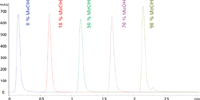Analysis of phosphate compounds with the Agilent 1260 Infinity Bio-inert Quaternary LC System
This application note shows that unspecific reaction of adenosine triphosphate can be completely prevented due to the iron- and steel-free design using the Agilent 1260 Infinity Bio-inert Quaternary LC System.
This application note shows that unspecific reaction of adenosine triphosphate can be completely prevented due to the iron- and steel-free design using the Agilent 1260 Infinity Bio-inert Quaternary LC System.
Severe peak tailing of phosphate compounds is a well described issue in HPLC analysis. Interaction between stainless steel and phosphate groups were described by Liu et al. leading to the formation of phosphopeptide-Fe(III) complexes (1). The 1260 Infinity Bio-inert Quaternary LC System provides a complete metal-free sample flow path throughout the system. With this system, the user can analyze a variety of phosphate compounds without the emersion of peak tailing or other unspecific reaction due to phosphate–iron complexes.
Experimental Conditions
Solvents: 10 mM ammonium acetate with increasing amount of methanol
Sample: Adenosine triphosphate (ATP), solved in H2Odd (5 mg/mL)
A PEEK restriction capillary was used instead of a stainless steel column.
Results
Significant peak tailing could be observed for ATP analysis in a stainless steel based system, the 1260 Infinity Quaternary LC System. With increasing amount of organic mobile phase, the retention of the phosphate compound was increasing to a huge extent, also resulting in relevant area reduction, see Figure 1.

Figure 1: ATP analysis on Agilent 1260 Infinity Quaternary System.
With the 1260 Infinity Bio-inert Quaternary LC System, the unspecific reaction of the used phosphate sample could be completely prevented, resulting in good peak shapes without substantial peak tailing or area reduction, see Figure 2.

Figure 2: ATP analysis on the Agilent 1260 Infinity Bio-inert Quaternary System.
Conclusions
Unspecific reaction and peak tailing of adenosine triphosphate could be completely prevented when using the Agilent 1260 Infinity Bio-inert Quaternary LC System. Due to the iron- and steel-free design of the 1260 Infinity Bio-inert Quaternary LC system, phosphate compounds can be analyzed without any issues regarding the formation of phosphate–iron complexes as found with stainless steel systems.
Reference
(1) Liu et al., Rapid Commun. Mass Spectrom.19(19), 2747–2756 (2005).
Agilent Technologies, Inc.
5301 Stevens Creek Blvd., Santa Clara, CA 95051
(800) 227-9770 (Directory), fax (866) 497-1134
Website: www.agilent.com

SEC-MALS of Antibody Therapeutics—A Robust Method for In-Depth Sample Characterization
June 1st 2022Monoclonal antibodies (mAbs) are effective therapeutics for cancers, auto-immune diseases, viral infections, and other diseases. Recent developments in antibody therapeutics aim to add more specific binding regions (bi- and multi-specificity) to increase their effectiveness and/or to downsize the molecule to the specific binding regions (for example, scFv or Fab fragment) to achieve better penetration of the tissue. As the molecule gets more complex, the possible high and low molecular weight (H/LMW) impurities become more complex, too. In order to accurately analyze the various species, more advanced detection than ultraviolet (UV) is required to characterize a mAb sample.















